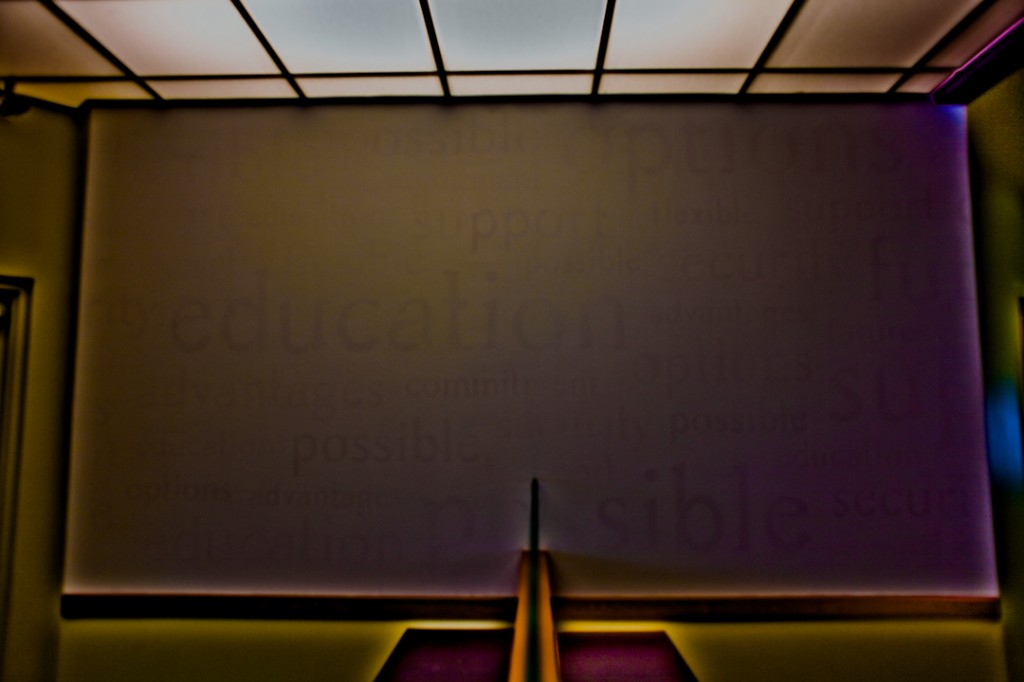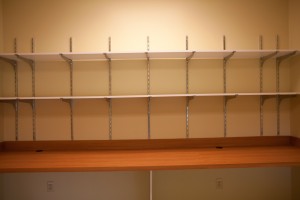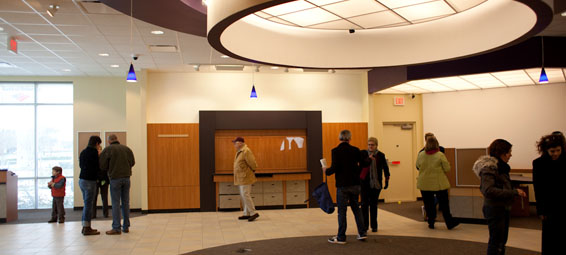Ed. note: The following roundtable was held February 14 to discuss the show “Modern Ruin,” which will exhibit over the course of two days work by 15 artists in a never-used Washington Mutual bank building. On Monday, February 22, the building will be demolished.
Noah Simblist: We gathered over Sunday morning brunch to talk about the upcoming exhibition “Modern Ruin,” which opens at 8 p.m. on February 20 in a former bank building at 5030 Greenville Ave. just south of Lovers Lane in Dallas.
Christina Rees organized “Modern Ruin” with Thomas Feulmer. Richard Patterson, Terry Thornton, Margaret Meehan and myself are a small cross section of the fifteen participating artists involved. But our conversation will give you a sense of what some of us are thinking about going into this exhibition.
Christina, give us brief into to the show.
Christina Rees: The idea started when Thomas’ partner Leland was lamenting this bank building. The Morning News had done a story on the empty bank building and there was a photograph of Leland standing in the lobby, and we were laughing about it – talking about it, and somebody said we should do a show there. Leland is a real estate guy, and he seemed kind of intrigued and a little bit skeptical, but once that seed was planted, I don’t think Thomas or I would ever really let it go. Leland needed a new tenant on that land. So because Washington Mutual had been seized by the government and given to JP Morgan Chase, and JP Morgan Chase did not want to use the building, Leland at that point became the default owner of not just the land, but the building itself. Once he was confident that a new tenant would move onto the land then he started to think that maybe there was some use for this building as an artist action.
We put together a short list of artists who we really felt would be ideal for this kind of project. It wasn’t just our favorite people or our favorite artists, it was people who we felt that their previous bodies of work or things they had been doing recently somehow sort of jived with the idea of getting in there and doing something intelligent. It could be more aggressive; it needed to be a real kind of dialogue with the building itself.
We went over there one night and we had flashlights and we felt like we were kids sneaking around, like cops and robbers or something like that – really strange and eerie – but the potential was so clear.
I’ve got so many emails from people who are almost stunned that this is happening, that there is this initiative that is happening, and a lot of people seem to understand the potential import. It is not so common in Dallas when artists take over a building. People say what is the difference between this and a pop-up gallery? In big cities where that sort of thing was common and has been historically, those buildings have had some sort of previous use in history. This is the only use this bank will ever have in its entire history. Its existence is going to be 15 artists coming in and doing stuff in a 48 hour period.
Terri Thornton: That’s what I loved about this – it had a purpose instead of just a desire to get something going. It started with the idea. That’s what I think is so strong. Does it deal with the financial crisis? I don’t think it would be happening without that. I think the whole attitude of nobody’s getting rich, nothing to lose, let’s just get out there and make this happen for ourselves – it’s exhilarating. I agree with you that it seems like it is happening more now, and maybe more now here, but I think it is so much the nature. I love it when these sort of things respond to a situation – it’s when they make sense. There’s no round peg being forced into a square hole. It is happening because . . .
Christina Rees: The opportunity was there and it made sense.
Terri Thornton: Yes. In a way it was screaming for it, and we’re just trying to be receptive. And you and Thomas were being receptive and picked up on something that needed to happen. And I think that is why you had such a quick and enthusiastic response from the artists. Because it feels like we all have our feelers out right now; we’re not just waiting for something to happen to us. Everyone is more alert, and sensitive, and on.
Christina Rees: And to go back to the historical context of this, that is true especially in a recession.

Noah Simblist: I’m wondering for you guys as artists, when you first heard about the project and actually went into the space, I know that you have had different ideas accumulate – how did those evolve, how were you thinking about the space and the idea?
Terri Thornton: I wanted to go in and read the space and really see what was there, because for me the space itself was pretty much a piece. So my response was sort of to intervene as slightly as possible. The words on the wall – I may be wrong about this, but I so hope that this is the right story – that the place is all designed, as banks are now, and it pops up quick and the design is of a sort. We all recognize it. And the fact that nobody occupied that building but somebody came in and white washed over these words of false encouragement. I just think, what else needs to happen to that wall except how do you enhance those words enough so that people begin to see them? People were suggesting, why don’t you paint those words so they stand out more? I’m trying to do it as slight as possible because it is so much more valuable to find them. I want people to experience the same thing I did, when I was like, “Oh my god! Look at that.” I want people to have that same kind of opportunity.
Margaret Meehan: Because you are not trying to recreate, just emphasize.
Terri Thornton: Exactly – and the same thing with “push” to open on the door. Immediately I thought there is something else that goes with it. “Push” is a very aggressive word, and in that context it is instructive. And I thought, “what else goes with push,” and so the phrase “Push comes to shove” comes to mind. And I thought – that’s pretty perfect. I’m trying to really be receptive to the space, whereas Cam [Schoepp], on the other hand, all of his responses have been, “how can I disrupt this, how can I intervene in a way that sort of physically competes with the conceptual potency of the space.” Tom Orr, deconstructing one side of the lobby and then reconstructing it on the other side, and the lobby is a mirror-image. That’s the other part of this design format — is that it is very symmetrical, very encouraging. It’s very comfortable. So for Tom and Cam and some others — and you Margaret — to go in and make it uncomfortable, I think is also an interesting response.
Margaret Meehan: And Tom was even saying in the process of getting starting, he was really clear about his intentions with actually working the space and working with the materials, things were shifting because the building was making him respond. So that was kind of an interesting take. For me the building very much — the idea, the building, and when we all met that morning, thinking back when you first discovered it like cops and robbers – it was this really adult context, not just us as adults, but the reality of why you are in that empty, electricity-gone sort of building. When I watched the 16-17 of us wandering around discovering, we were like kids getting really excited about something that was devastating on a certain level for a lot of people out there. The reality of the building and why it has been offered up for us. On a personal level,the building is the premise of this whole thing, I’m having a hard time understanding that you would not react to the building.

Noah Simblist: It is interesting in what you are both saying – that the crisis is this invisible thing that you need to make visible.
Terri Thornton: Exactly. It’s almost visible, and you sort of just need to bring it into focus a little bit, or that at least is my response.
Noah Simblist: Richard, how have you been thinking of the building as an idea?
Richard Patterson: I mean, it seemed like an idea I’ve been quite familiar with, like in London. But that was actually was the beginning of the boom, and so it was kind of the opposite. When I actually saw the building it felt kind of generic, that sort of abject – I thought, “Who designs this crap? Does any one even design it?” It is so horrible.

My first reaction was – the setting was so adverse to my sensibilities – at first I was going to put a painting in there, and then I thought, I can’t put a painting in there, that’s too weird. And then I thought I would have to do something really different, which was automatically interesting. But it is definitely a political reaction – it is as much a political reaction as an aesthetic one. So I have chosen videos that are essentially quite political, but are also optimistic, I think. And they are all about the idea of ownership and how you can never really own anything in the end. Given that the U.S. is completely phobic about anything that even faintly resembles socialism, it is kind of an interesting idea that the tax-payer had had to bail out the banks. And people are still resistant to even considering that idea. Just to suggest who really owns anything.
Christina Rees: Which means we sort of all own everything.
Richard Patterson: Right. And there’s certainly a relation to art. People look at the art objects, and they think of the art object as a concrete thing and it never changes, and they need to decode the meaning of the art object. And if they decode it, and they buy it, then they sort of truly own it. But what they forget is that the meaning of the object changes over time because context changes all the time. There’s only some semblance of ownership – perceptually or conceptually. So to bring all of that back into that space, it is a very interesting kind of paradime shift.
Margaret Meehan: And then also the idea that we talked about that a lot of the work will be demolished – that the work will go with the building.
Noah Simblist: But the great irony of it is that in some ways people think that you have an object that belongs to the artist and you sell it to the collector and it is this concrete thing that changes hands and you know exactly who owns it at every single moment. But all of us, as artists, are making things that don’t function like that in this space.Then in that bank, it is functioning much more the way capitalism really works, which is that you can’t grasp it – it’s dispersed, it’s diffused. It’s something that even though that bank is going to be demolished, it is not demolishing the banking industry. It’s not that capitalism is going to be demolished, it’s not that Washington Mutual itself is going away – the shareholders, the CEOs who went on to go to other places and get salaries.
Richard Patterson: I decided that I am not going to work with the space physically, but that I am going to bring in objects that I don’t necessarily own. So I was thinking of the bank as a depository for cash, supposedly, but of course it is really just a depository for numbers, in a sense. Interestingly, everyone looked for the vault, but there isn’t one, of course.
Noah Simblist: Yeah, where is the money? It is too expensive to have one.
Richard Patterson: So it really is just a giant ATM machine, is it what it is. So, to inhabit that giant ATM machine is strange.

Christina Rees: As artists, I wanted to ask you guys, are you that much more comfortable going in there and screwing with this place because it doesn’t foster any respect? If you walked into a place that had marble floors and marble columns and wood paneling, would you be reacting in the same way?
Richard Patterson: There’s no question it changes. My first thought was to drive a Toyota through the window. It could be any car, but a Prius would have been a good one to go through the front window because it would have been that kind of comical irony.
Terri Thornton: There is no regret – there is a great deal of pleasure being destructive in this space, and the fact that this place will be leveled – it is unbelievable that there is absolutely no twinge of, “Oh my gosh, this is going to be leveled.” It’s like everything is coming full circle as it should.
Richard Patterson: The idea of a bank or any other capitalist institution. If you compare the bank to the Fort Worth Modern, the modernist aspires – the contemporary museum aspires to be a kind of contemporary cathedral, in a sense, and it is meant to inspire extreme reverence and calm and some sort of god or other. Banks are sort of insecurity: greed and basic needs in a sense. I don’t resent the idea of it – the problem is just the quality. And that’s what everyone is complaining about Wall Street.
Terri Thornton: That’s what’s so beautiful about all of this: it has pulled all of that into question. The bank itself is representative.
Noah Simblist: When I first saw the building, at first I was like, “Ugh, what the hell am I going to do with that?” The most immediate reaction wasn’t just sort of a, “Wow this is great,” or like, “Oh this is crap so I can do anything to it.” It was like, oh nothing – just nothing. Because often you need some sort of resistance, something to work with, to push up against. But it felt so vapid.
Margaret Meehan: And that something was when all those artists went in.
Noah Simblist: Yeah, we created the kind of the infrastructure for that space.
All photos courtesy of Kevin Todora.





